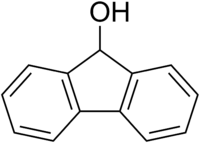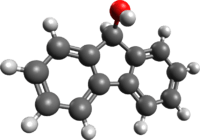Fluorenol
 | |
 | |
| Names | |
|---|---|
| IUPAC name
9H-Fluoren-9-ol | |
| Other names
9-Hydroxyfluorene | |
| Identifiers | |
| 1689-64-1 | |
| 3D model (Jmol) | Interactive image |
| ChEBI | CHEBI:16904 |
| ChemSpider | 66916 |
| ECHA InfoCard | 100.015.345 |
| EC Number | 216-879-0 |
| PubChem | 74318 |
| |
| |
| Properties | |
| C13H10O | |
| Molar mass | 182.22 g/mol |
| Appearance | Off-white crystalline powder |
| Density | 1.151 g/mL |
| Melting point | 152 to 155 °C (306 to 311 °F; 425 to 428 K) |
| Practically insoluble [2] | |
| Hazards | |
| NFPA 704 | |
| Except where otherwise noted, data are given for materials in their standard state (at 25 °C [77 °F], 100 kPa). | |
| | |
| Infobox references | |
Fluorenol is an alcohol derivative of fluorene. In the most significant isomer, fluoren-9-ol or 9-hydroxyfluorene, the hydroxy group is located on the bridging carbon between the two benzene rings. Hydroxyfluorene can be converted to fluorenone by oxidation. It is a white-cream colored solid at room temperature.
Toxicity
Fluorenol is toxic to aquatic organisms including algae, bacteria, and crustaceans.[3] Fluorenol was patented as an insecticide in 1939,[4] and is an algaecide against the green algae Dunaliella bioculata.[5]
Its toxicity and carcinogenicity in humans are unknown.[5]
Wakefulness-promoting agent
A study published by chemists working for the biopharmaceutical company Cephalon to develop a successor to the wakefulness-promoting agent (or eugeroic) modafinil reported that fluorenol was 39% more effective than modafinil at keeping mice awake over a 4-hour period.[6] It is a weak dopamine reuptake inhibitor with an IC50 of 9 μM, notably 59% weaker than modafinil (IC50 = 3.70 μM) despite being a stronger wakefulness-promoting agent, potentially making it even less liable for addiction.[7] It also showed no affinity for cytochrome P450 2C19, unlike modafinil.[6]
See also
References
- ↑ 9-Hydroxyfluorene, chemicalland21.com
- ↑ Record of 9H-Fluoren-9-ol in the GESTIS Substance Database of the IFA, accessed on 5 November 2008
- ↑ Šepič, Ester; Bricelj, Mihael; Leskovšek, Hermina (2003). "Toxicity of fluoranthene and its biodegradation metabolites to aquatic organisms". Chemosphere. 52 (7): 1125–33. doi:10.1016/S0045-6535(03)00321-7. PMID 12820993.
- ↑ US patent 2197249: Insecticide
- 1 2 MSDS
- 1 2 Dunn, D.; Hostetler, G.; Iqbal, M.; Marcy, V. R.; Lin, Y. G.; Jones, B.; Aimone, L. D.; Gruner, J.; Ator, M. A.; Bacon, E. R.; Chatterjee, S. (2012). "Wake promoting agents: Search for next generation modafinil, lessons learned: Part III". Bioorganic & Medicinal Chemistry Letters. 22 (11): 3751–3753. doi:10.1016/j.bmcl.2012.04.031. PMID 22546675.
- ↑ Wise, R. A. (1996). "Neurobiology of addiction". Current Opinion in Neurobiology. 6 (2): 243–51. doi:10.1016/S0959-4388(96)80079-1. PMID 8725967.
